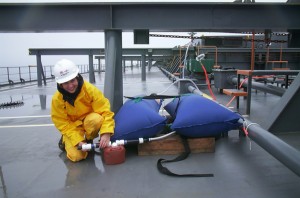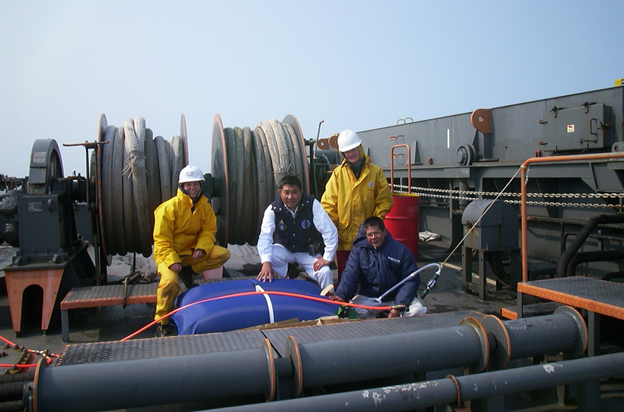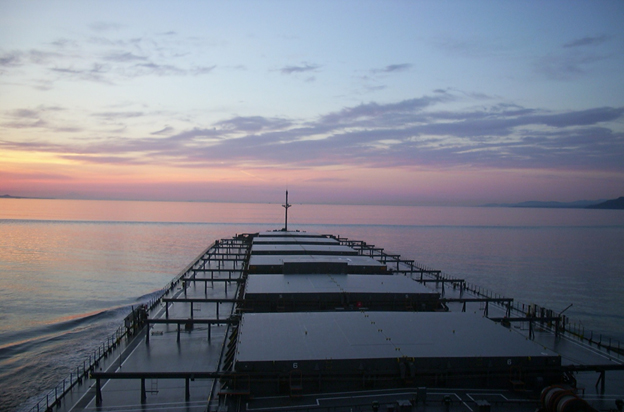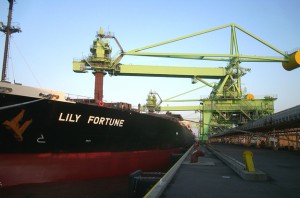by Monaca Noble, marine invasions biologist
Her name was the Lily Fortune. She was a huge red and black cargo ship hauling coal from Canada to a power plant in Japan. Her 10 cargo holds were amazingly clean considering her sooty merchandise. The captain and crew were from the Philippines and were delighted to have two scientists aboard to break up the monotony of their year-long service tours.
Kate Murphy and I flew to Haramachi, Japan, in the spring of 2003. It was only the second time I had used my new passport and I was excited to be going somewhere exotic. It was a new project for both of us, but especially for me. I had never been on a ship or seen a ballast tank. Since we’d be 10 days at sea, Kate wanted to make sure we had everything we could possibly need—pumps, filters, hoses, tools, etc. As a result we had a huge amount luggage. We were picked up from the airport in a cargo van sent by the shipping company. There was no room for us to sit, except for in the back on top of our equipment. I was so excited to see Japan and spent the hour-long ride to the port peering out the tiny window in the back of the van trying to make out as much of the scenery as I could. Unfortunately when we arrived at the port and checked in, we were told we could not go further than the dock. Four days in Japan and we couldn’t leave the ship! It was disappointing. But the disappointment of not seeing Japan was soon replaced with the excitement of being on a commercial ship, getting to know the crew, and setting up our new experiment. There was plenty to keep us busy in the days before the ship sailed.
We were on this ship to measure the naturally-occurring chemical attributes of seawater to determine if any could be used to distinguish port water in ballast tanks from the mid-ocean water in an exchanged tank. We aimed to sample for salinity, dissolved organic matter, radium isotopes and trace elements such as barium, phosphorus and manganese.
Ballast water is used by ships that don’t have a full load of cargo for weight and stability during sailing. On this trip the ship had a lot of ballast water because it had unloaded its coal in Japan and wasn’t carrying any cargo back to Canada. Ballast water taken on in ports can contain thousands of organisms that could be transferred from one port to another. In order to prevent the spread of invasive species, and aid us in our experiment, the crew of the Lily Fortune replaced the port water in their ballast tanks with water from the mid-ocean, a process called ballast water exchange. Ballast water exchange can reduce the risk of species introductions because mid-ocean water contains fewer organisms, and few of those can survive outside the mid-ocean environment.

To test water samples for radium isotopes, Monaca Noble (pictured) and Kate Murphy had to filter 300 liters of ballast water through a manganese-soaked fiber, while attempting to keep the two water-filled bladders from rolling across the ship. (SERC)
In addition to ballast water samples, we also collected numerous water samples from the ocean along the route through an intake pipe in the lowest level of the ship’s engine room. The engine room was much more than one room; it was a huge area at the rear of the ship several stories high. I was totally amazed by the ship’s engine, not only by its size but also by how clean it was. It was shiny and new, and hummed more loudly than a car engine. Going to the bottom of the engine room to collect our samples involved going down many flights of very steep stairs. We took samples each hour at the beginning and end of the voyage and less frequently in the middle of the voyage.
We worked hard but had a great time. The captain, Tony, and his crew were wonderful. Meals were taken in the officer’s dining room with the captain, chief engineer and chief mate. On slower days Tony would tell us tales of life at sea, and the chief engineer would tell us about life in the Philippines with his wife and children. Before our departure in Vancouver, Canada, the crew threw us a party. They had a full band, and Tony played the drums. We sang and danced for much of the evening.

Monaca and Kate, beside a radium bladder with the captain and chief engineer of the Lily Fortune. (SERC)
This first voyage in 2003 I thought was the beginning and end of my adventures at sea. But two years later, Kate and I met again for a voyage to Hawaii. Later that same year I had the opportunity to lead more voyages and train others to collect ballast samples as one of three team leads on a large project testing ballast water tracers in the Pacific region. Our 2012 paper describing some of the results from this study has just been published and is discussed in the December Feature Story on the Marine Invasions Lab’s website.
Conducting research has many parts, starting from an idea and moving from proposal, to data collection, to analysis and, finally, to publication. The role of the research technician is largely at the data collection stage. While this stage has its challenges, it can also be the most fun and, for many of us, this is the reason we got into science in the first place.
Scientific research is an adventure that can take you places you never dreamed possible. I would like to encourage other people thinking about a career in science to go for it. You never know where the path will lead.



